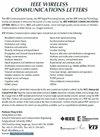在空中无线网络中进行 FedMeta 学习的通信感知优化器
IF 5.5
3区 计算机科学
Q1 COMPUTER SCIENCE, INFORMATION SYSTEMS
引用次数: 0
摘要
联邦元学习(federmeta)将元学习与联邦学习(FL)集成在一起,以解决边缘智能中的异构挑战。在无人驾驶飞行器(uav)辅助空中网络上实施FedMeta提供了复合效益,包括最佳轨迹设计和资源分配。FedMeta对具有最小数据的新边缘设备的快速适应性在不利的基于无人机的无线网络中受到挑战,因为频繁的更新丢失会导致模型偏差和对来自具有更好通道的设备的数据的过拟合。在这封信中,我们提出了一个适用于不利信道条件的全局FedMeta模型更新的优化器。我们表明,提出的优化器优于最先进的AdamW优化器用于FedMeta学习。通过利用随机几何工具,特别是在无人机编排的网络中,我们可以深入了解通道行为并将其集成到我们的算法中。我们还引入了一种新的混合更新规则,将我们的优化策略与AdamW相结合,获得了更好的收敛速度和整体精度。在不可靠信道条件下对LEAF数据集的大量模拟验证了我们方法的有效性。本文章由计算机程序翻译,如有差异,请以英文原文为准。
Communication-Aware Optimizers for FedMeta Learning in Aerial Wireless Networks
Federated Meta (FedMeta) learning integrates meta learning with Federated Learning (FL) towards addressing heterogeneity challenges in edge intelligence. Implementing FedMeta on uncrewed aerial vehicles (UAVs)-assisted aerial networks offers compound benefits, including optimal trajectory design and resource allocation. The quick adaptability of FedMeta to new edge devices with minimal data is challenged in adverse UAV-based wireless networks due to frequent update losses that lead to model bias and overfitting towards data from devices with better channels. In this letter, we propose an optimizer for the global FedMeta model update that is suitable for adverse channel conditions. We show that the proposed optimizer outperforms the state-of-the-art AdamW optimizer for FedMeta learning. By leveraging tools from stochastic geometry, particularly in UAV-orchestrated networks, we gain insights into channel behavior and integrate them into our algorithm. We also introduce a novel hybrid update rule combining our optimized strategy with AdamW, achieving superior convergence speed and overall accuracy. Extensive simulations on LEAF datasets under unreliable channel conditions validate the effectiveness of our methods.
求助全文
通过发布文献求助,成功后即可免费获取论文全文。
去求助
来源期刊

IEEE Wireless Communications Letters
Engineering-Electrical and Electronic Engineering
CiteScore
12.30
自引率
6.30%
发文量
481
期刊介绍:
IEEE Wireless Communications Letters publishes short papers in a rapid publication cycle on advances in the state-of-the-art of wireless communications. Both theoretical contributions (including new techniques, concepts, and analyses) and practical contributions (including system experiments and prototypes, and new applications) are encouraged. This journal focuses on the physical layer and the link layer of wireless communication systems.
 求助内容:
求助内容: 应助结果提醒方式:
应助结果提醒方式:


